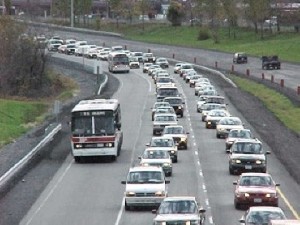My ideal form of transit is rail (heavy or light), speedily connecting compact urban neighborhoods filled with people, recreational destinations, offices, and public events/festivals. But building these rail system, especially in California, takes way too long and costs way too much. Some cases in point: the Wilshire subway in Los Angeles won’t be coming to Westwood until 2037 at the earliest, and high speed rail won’t be connecting San Francisco to Los Angeles until 2028, which is optimistic at best.
In the meantime, city leaders should not let people remain stuck in traffic with no alternative and preclude the opportunity to build more transit-oriented neighborhoods. Even if you love rail, given that it’s going to take decades and billions to build these systems, cities should focus on immediate solutions that provide more convenience than cars and that channel future growth around transit.
And that means significant improvements to existing bus networks.
Now, as I’ve written, people generally don’t like buses. Low-income and other transit-dependent riders often find them to be slow, relatively expensive, and time consuming. Those who can afford to drive share those concerns and greatly prefer rail to buses, perceiving the bus as dirty, unpleasant and dangerous.
But when we think of the value of rail, most of it boils down to speed and time savings, with the bonus of a comfortable, electric ride. When built right, buses can achieve many of these benefits. The key is to prioritize buses over autos with dedicated lanes, pre-boarding ticket purchases, and traffic signal priority. Streetsblog LA recently posted a number of ways to speed up bus service. The article mentions those methods but also the importance of bus-only lanes on freeways. Particularly in cities like Los Angeles, bus-only freeway lanes would provide massive time savings at low cost and largely track existing commuting patterns. As I discuss in Railtown, President Carter and his administration strongly encouraged Los Angeles to pursue this option over expensive new rail lines.
The advent of new highway toll lanes could provide opportunities for expanded bus-only opportunities. Not only do these toll lanes provide revenue that can be used for transit, but they could be made available to buses for fast, efficient service. Win-win.
Ultimately, the political pushback from car drivers has proven too great to see bus-only lanes put in place, and toll lanes have faced resistance, too. But given the delays and costs associated with rail, transit advocates and the interested public should get behind these solutions for immediate traffic relief.
It beats sitting in traffic and waiting decades for a rail transit savior.
Leave a Reply
You must be logged in to post a comment.



